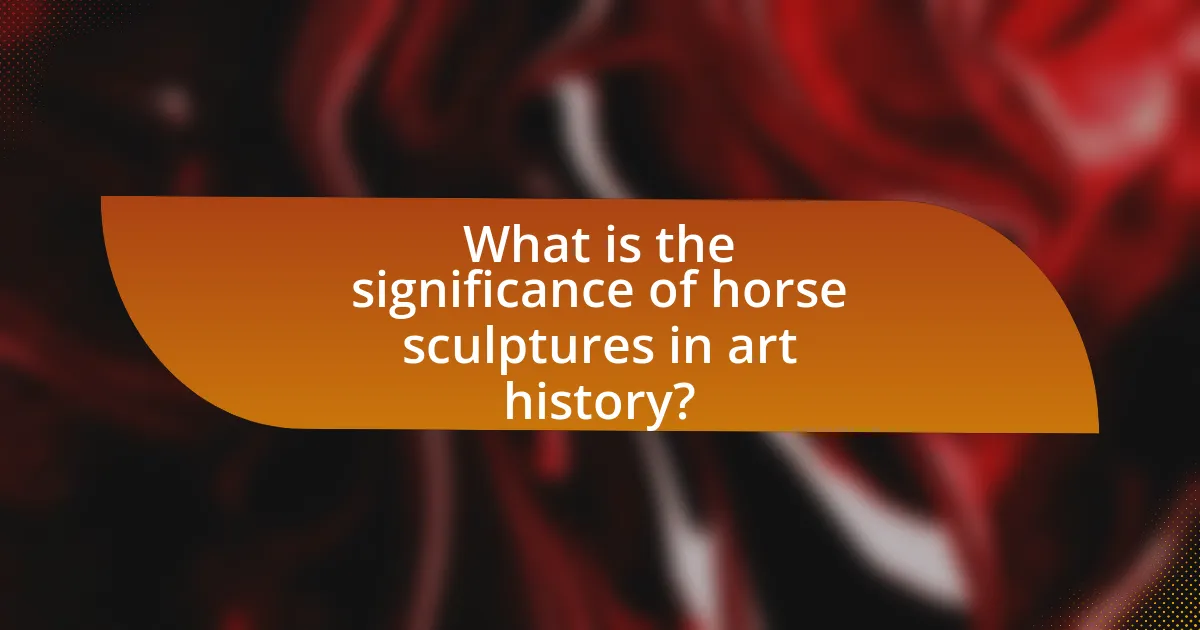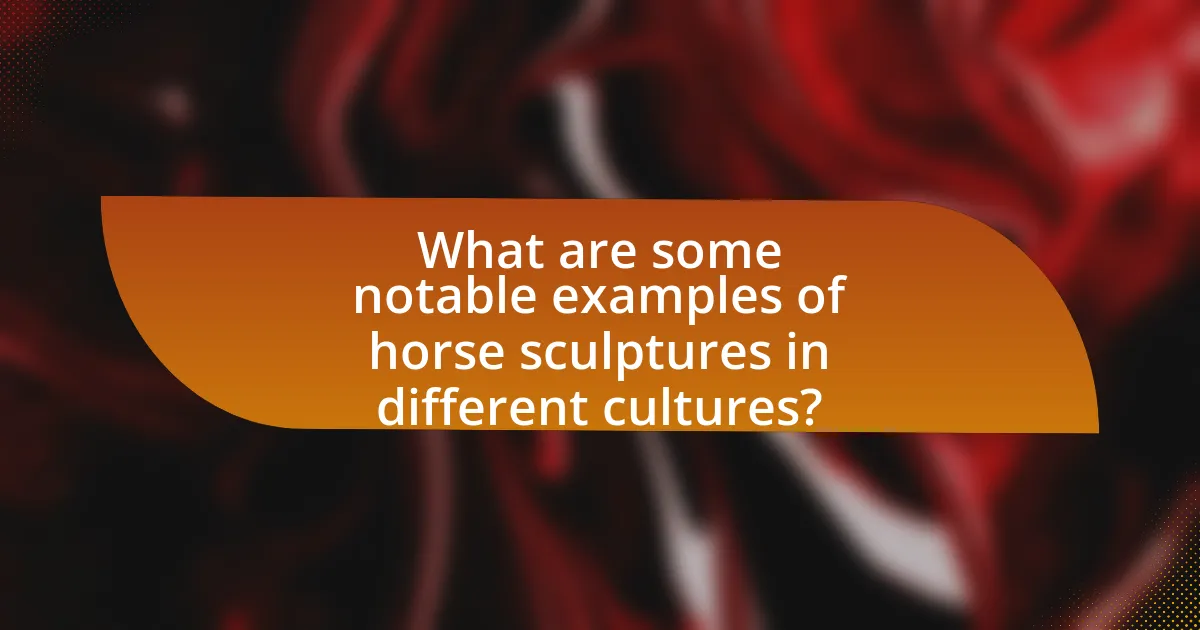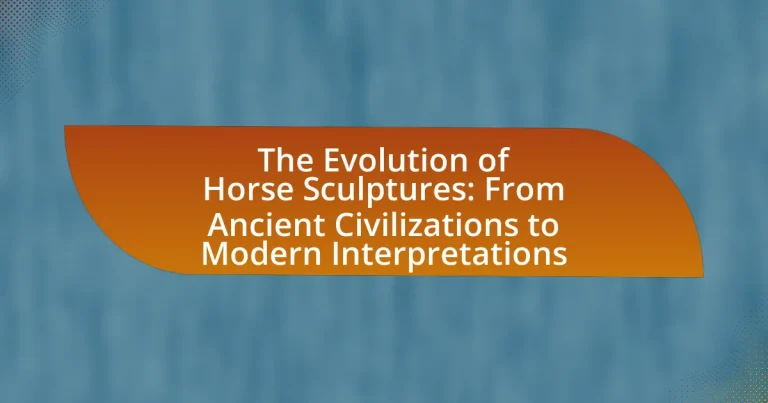The article examines the evolution of horse sculptures from ancient civilizations to modern interpretations, highlighting their significance in art history as symbols of power, nobility, and the human-animal relationship. It explores the stylistic changes across various cultures, including ancient Mesopotamia, Greece, Rome, and Asia, detailing how these sculptures reflect societal values and artistic advancements. The discussion includes notable examples, key styles, and the impact of technology on contemporary horse sculptures, as well as their role in public art and community identity. Additionally, the article provides insights into best practices for appreciating and collecting horse sculptures, emphasizing the importance of craftsmanship and historical context.

What is the significance of horse sculptures in art history?
Horse sculptures hold significant importance in art history as they symbolize power, nobility, and the relationship between humans and animals. Throughout various cultures, such as in ancient Greece and Rome, horse sculptures were often used to commemorate victories and honor deities, reflecting their status in society. For instance, the famous equestrian statue of Marcus Aurelius in Rome, dating back to the 2nd century AD, exemplifies the use of horse sculptures to convey authority and leadership. Additionally, in Asian art, such as Chinese dynastic sculptures, horses represent strength and loyalty, further emphasizing their cultural relevance. The consistent depiction of horses across different eras and regions illustrates their enduring significance in artistic expression and societal values.
How have horse sculptures evolved through different civilizations?
Horse sculptures have evolved significantly across various civilizations, reflecting cultural values, artistic styles, and technological advancements. In ancient Mesopotamia, for instance, horse sculptures were often stylized and symbolic, serving religious or ceremonial purposes, as seen in the Assyrian reliefs depicting horses in battle. The Greeks later introduced more realistic representations during the Classical period, emphasizing anatomical accuracy and dynamic poses, exemplified by the famous bronze statue of the horse from the Hellenistic era. In Asia, particularly in China, horse sculptures became prominent during the Tang Dynasty, where they were intricately crafted to symbolize power and status, often found in tombs. The Renaissance period in Europe saw a resurgence of interest in classical forms, leading to grand equestrian statues, such as those by Donatello and Leonardo da Vinci, which showcased both artistic skill and the importance of horses in society. In contemporary art, horse sculptures have diversified into various materials and styles, reflecting modern interpretations and conceptual approaches, as seen in the works of artists like Deborah Butterfield, who uses found materials to create abstract representations of horses. This evolution illustrates how horse sculptures have continuously adapted to the changing cultural and artistic landscapes throughout history.
What are the earliest known examples of horse sculptures?
The earliest known examples of horse sculptures date back to around 3500-3000 BCE, originating from the ancient civilizations of Mesopotamia. These sculptures include small figurines made from materials such as clay and stone, often depicting horses in a stylized manner. Notably, the Uruk period in Mesopotamia produced some of the first representations of horses, reflecting their significance in agriculture and warfare. Archaeological findings, such as those from the site of Ur, provide concrete evidence of these early artistic expressions, showcasing the cultural importance of horses in early human societies.
How did ancient cultures depict horses in their sculptures?
Ancient cultures depicted horses in their sculptures with a focus on realism and symbolic representation. For instance, the Greeks created detailed marble statues that showcased the horse’s musculature and movement, reflecting their admiration for equestrian skills and the horse’s role in warfare and sport. Similarly, the ancient Chinese produced bronze sculptures, such as those found in the tomb of the General Zhang Xun, which emphasized the horse’s strength and nobility, often associating it with power and status. These artistic representations were not only aesthetic but also served to convey cultural values and beliefs surrounding horses in society.
Why are horses a popular subject in sculpture?
Horses are a popular subject in sculpture due to their historical significance, aesthetic appeal, and symbolic representation of strength and freedom. Throughout history, various cultures have depicted horses in art to celebrate their roles in agriculture, warfare, and transportation, as seen in ancient civilizations like the Greeks and Romans, who created detailed equestrian statues. The aesthetic qualities of horses, including their grace and power, make them compelling subjects for artists, allowing for dynamic representations in various styles. Additionally, horses symbolize ideals such as nobility and loyalty, further enhancing their popularity in artistic expression.
What cultural meanings do horses represent in various societies?
Horses represent various cultural meanings across societies, symbolizing power, freedom, and nobility. In ancient civilizations, such as the Greeks and Romans, horses were associated with warfare and status, often depicted in sculptures and art to signify strength and heroism. In many Indigenous cultures, horses symbolize connection to the land and spiritual journeys, reflecting their importance in daily life and rituals. Additionally, in Eastern cultures, horses are often seen as symbols of prosperity and good fortune, as evidenced by their frequent appearance in traditional art and folklore. These diverse representations highlight the multifaceted role of horses in human culture throughout history.
How do horses symbolize power and nobility in art?
Horses symbolize power and nobility in art through their depiction as majestic and strong creatures often associated with leadership and status. In various cultures, such as in ancient Rome and Greece, horses were frequently portrayed in sculptures and paintings to represent the might of warriors and rulers, reinforcing their elevated social standing. For instance, the famous equestrian statue of Marcus Aurelius exemplifies how horses were used to convey authority and grandeur, showcasing the ruler’s dominance and virtue. Additionally, in the Renaissance, artists like Leonardo da Vinci and Donatello continued this tradition, emphasizing the horse’s grace and strength to symbolize the nobility of their subjects. This consistent representation across different eras and cultures underscores the enduring association of horses with power and nobility in artistic expression.

What are the key styles of horse sculptures throughout history?
Key styles of horse sculptures throughout history include Classical, Baroque, and Modern styles. Classical horse sculptures, originating in ancient Greece and Rome, often depicted horses in a realistic manner, emphasizing anatomical accuracy and dynamic poses, as seen in works like the “Cavalryman” from the Parthenon frieze. The Baroque period introduced dramatic movement and emotional expression, exemplified by Gian Lorenzo Bernini’s “Equestrian Statue of Louis XIV,” which showcased grandeur and power. In contrast, Modern horse sculptures, emerging in the 20th century, often embraced abstraction and experimentation, as demonstrated by the works of artists like Alberto Giacometti, who focused on form and existential themes. Each style reflects the cultural and artistic values of its time, illustrating the evolving relationship between humans and horses throughout history.
How did the styles of horse sculptures change from ancient to modern times?
The styles of horse sculptures evolved significantly from ancient to modern times, reflecting changes in artistic techniques, cultural values, and societal contexts. In ancient civilizations, such as those in Greece and Rome, horse sculptures often emphasized realism and idealized forms, showcasing the horse’s strength and beauty, as seen in works like the Parthenon friezes. In contrast, modern horse sculptures tend to explore abstraction and conceptual interpretations, focusing on emotional expression and movement rather than strict realism, as exemplified by contemporary artists like Deborah Butterfield, who uses found materials to convey the essence of horses. This shift illustrates a broader trend in art from representational to abstract forms, influenced by movements such as Impressionism and Modernism.
What are the defining characteristics of classical horse sculptures?
Classical horse sculptures are characterized by their realistic anatomical representation, dynamic poses, and intricate detailing. These sculptures often depict horses in motion, showcasing their strength and grace, which reflects the importance of horses in ancient cultures for transportation, warfare, and agriculture. The use of materials such as marble and bronze allowed for fine details, including musculature and facial expressions, enhancing the lifelike quality of the sculptures. Historical examples, such as the famous “Cavalry Horse” from ancient Greece, illustrate these characteristics, emphasizing the skill of the artists in capturing the essence of the horse.
How did the Renaissance influence horse sculpture styles?
The Renaissance significantly influenced horse sculpture styles by emphasizing realism, anatomical accuracy, and dynamic poses. Artists such as Donatello and Leonardo da Vinci studied horses extensively, leading to sculptures that captured the musculature and movement of the animal more effectively than in previous periods. This shift towards naturalism is evident in works like Donatello’s “Gattamelata,” which showcases a detailed representation of a horse in a lively stance, reflecting the Renaissance’s focus on observation and the human experience. The period’s revival of classical ideals also inspired sculptors to incorporate heroic and noble themes, further enhancing the artistic portrayal of horses in sculpture.
What modern techniques are used in creating horse sculptures?
Modern techniques used in creating horse sculptures include 3D printing, digital modeling, and mixed media applications. 3D printing allows artists to create intricate designs with precision, enabling the production of complex forms that would be difficult to achieve through traditional methods. Digital modeling software, such as Rhino or Blender, facilitates the design process, allowing for easy modifications and visualizations before physical creation. Additionally, mixed media techniques combine materials like metal, wood, and resin, offering diverse textures and finishes that enhance the overall aesthetic of the sculpture. These advancements reflect a shift towards integrating technology in art, providing artists with innovative tools to express their creativity.
How has technology impacted the production of horse sculptures?
Technology has significantly transformed the production of horse sculptures by introducing advanced tools and techniques that enhance precision and creativity. The use of 3D printing technology allows artists to create intricate designs that were previously difficult to achieve with traditional methods, enabling rapid prototyping and customization. Additionally, digital sculpting software provides artists with the ability to visualize and manipulate their designs in a virtual space, streamlining the creative process. For instance, artists can now use CNC machines to carve materials with high accuracy, reducing manual labor and time required for production. These technological advancements have not only improved the quality of horse sculptures but also expanded the possibilities for artistic expression in this medium.
What materials are commonly used in contemporary horse sculptures?
Contemporary horse sculptures are commonly made from materials such as bronze, steel, wood, and resin. Bronze is favored for its durability and ability to capture fine details, while steel offers a modern aesthetic and strength. Wood provides a natural look and warmth, and resin allows for intricate designs and versatility in color. These materials reflect the evolution of artistic techniques and preferences in modern sculpture, showcasing both traditional craftsmanship and innovative approaches.

What are some notable examples of horse sculptures in different cultures?
Notable examples of horse sculptures across different cultures include the ancient Greek statue of the “Horse of Selene,” which adorned the Parthenon and symbolizes the importance of horses in Greek mythology and culture. In Chinese culture, the “Terracotta Army” features numerous life-sized horse sculptures that were buried with the first Emperor Qin Shi Huang around 210-209 BCE, reflecting the significance of horses in warfare and status. Additionally, the “Cavalry Horse” sculpture from the Mongolian Empire represents the central role of horses in nomadic lifestyles and military conquests. Each of these sculptures illustrates the cultural reverence for horses, showcasing their roles in mythology, warfare, and social status throughout history.
Which famous horse sculptures have shaped public perception?
Famous horse sculptures that have shaped public perception include the “Equestrian Statue of Marcus Aurelius,” which symbolizes power and authority, and “The Horse and Rider” by Alberto Giacometti, representing existential themes. The “Equestrian Statue of Gattamelata” by Donatello is another significant work, showcasing Renaissance ideals of humanism and valor. Each of these sculptures has influenced cultural views on leadership, strength, and the human condition, reflecting societal values during their respective eras.
What is the story behind the iconic “Charging Bull” sculpture?
The “Charging Bull” sculpture, created by artist Arturo Di Modica in 1989, symbolizes strength and resilience in the face of adversity. Di Modica crafted the bull as a response to the stock market crash of 1987, intending to inspire optimism and confidence in the American economy. The sculpture was initially placed in front of the New York Stock Exchange without permission, but it quickly became a symbol of Wall Street and financial prosperity. Its placement in Bowling Green Park in Manhattan solidified its status as an iconic representation of bullish market sentiment.
How does the “Mustang Monument” reflect contemporary views on horses?
The “Mustang Monument” reflects contemporary views on horses by symbolizing the wild spirit and freedom associated with mustangs, which resonates with modern values of conservation and animal rights. This monument, created by artist Laura Kimpton, emphasizes the importance of preserving the natural habitat of wild horses, aligning with current societal concerns about environmental sustainability and the ethical treatment of animals. The monument’s design, featuring a large sculpture of a mustang, serves as a powerful reminder of the cultural significance of horses in American history and their role in the ecosystem, reinforcing the contemporary appreciation for their autonomy and the need for their protection.
What role do horse sculptures play in modern public art installations?
Horse sculptures in modern public art installations serve as powerful symbols of cultural heritage, artistic expression, and community engagement. These sculptures often reflect historical significance, as horses have been integral to human civilization for centuries, representing strength, freedom, and movement. For instance, contemporary installations like “The Kelpies” in Scotland, which are 30-meter-high horse-head sculptures, celebrate the region’s equine history and draw significant tourist interest, demonstrating how such artworks can enhance local identity and economy. Additionally, horse sculptures can provoke thought and dialogue about themes such as nature, mythology, and the relationship between humans and animals, thereby enriching the public art landscape.
How do horse sculptures contribute to community identity and pride?
Horse sculptures contribute to community identity and pride by symbolizing cultural heritage and shared values. These sculptures often reflect the historical significance of horses in local traditions, economies, and lifestyles, reinforcing a sense of belonging among community members. For instance, in many regions, horse sculptures commemorate local equestrian events or historical figures associated with horse culture, fostering communal pride and identity. Additionally, public installations of horse sculptures can serve as landmarks, enhancing community visibility and attracting tourism, which further strengthens local identity and pride.
What are best practices for appreciating and collecting horse sculptures?
To appreciate and collect horse sculptures effectively, one should focus on understanding the historical context, artistic style, and material used in each piece. Knowledge of the evolution of horse sculptures, from ancient civilizations like the Greeks and Romans to modern interpretations, enhances appreciation. Collectors should research the provenance of sculptures, ensuring authenticity and value, as well as consider the reputation of the artist or sculptor, which can significantly impact the sculpture’s worth. Additionally, proper display and care, including appropriate lighting and humidity control, are essential for preserving the integrity of the sculptures. Engaging with art communities and attending exhibitions can also provide insights and foster connections with other collectors and enthusiasts.
How can one identify quality in horse sculptures?
To identify quality in horse sculptures, one should examine the craftsmanship, attention to detail, and the material used. High-quality horse sculptures typically exhibit precise anatomical accuracy, capturing the horse’s musculature and movement realistically. The surface finish should be smooth and well-executed, reflecting the artist’s skill. Additionally, the choice of material—such as bronze, marble, or high-grade wood—can indicate quality, as these materials are durable and allow for intricate detailing. Historical examples, such as the ancient Greek sculptures of horses, demonstrate that quality is often associated with the artist’s ability to convey emotion and dynamism, further validating the importance of these criteria in assessing contemporary works.
What should collectors consider when acquiring horse sculptures?
Collectors should consider the authenticity, historical significance, and craftsmanship of horse sculptures when acquiring them. Authenticity ensures that the piece is genuine and not a reproduction, which can significantly affect its value. Historical significance relates to the context in which the sculpture was created, as pieces from renowned artists or specific periods often command higher prices. Craftsmanship involves evaluating the quality of materials and the skill involved in the sculpture’s creation, as superior craftsmanship typically indicates a higher value. For instance, sculptures from ancient civilizations, such as those from Greece or Rome, are often more sought after due to their cultural importance and the techniques used at the time.


